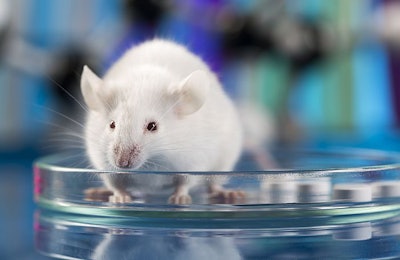
Geneticists have studied mice for decades and developed a greater knowledge of their DNA than most other animals. Shannon Falconer, PhD, CEO of Because Animals, applied that biochemical knowledge when making cell-cultured mouse-meat for use as a novel ingredient in cat treats. Because Animals does not yet sell their mouse muscle cat treats, but already has plans to tackle regulatory issues and expand their product line.
Advantages of cell cultured mice over other meat
“Currently, cultured meat is expensive, including cultured mouse,” Falconer said. “But one of our biggest assets is that we're working with tissue from a species where a lot is already known in terms of biochemistry.

Not only do scientists know more about how to grow mouse meat for pet food, making treats for cats provides advantages to pleasing hungry humans.
“The benefit of working in pet food is that mouse tissue is only one ingredient among several others needed to make our cultured mouse cat treat,” Falconer said. “Unlike the human food industry, where folks are working on growing an entire chicken breast that has all of the three-dimensional properties of chicken breast from chicken, we're simply growing a monolayer of mouse tissue and including it with other ingredients to make a cat treat. That's a lot easier and cheaper.”
Regulation of cultured mouse meat in human and pet food
Scientists may have a long history of studying with mice, but cats have hunted mice since long before humans arrived with can openers. Because Animals plans to seek U.S. regulatory approval for cell-cultured mouse meat as generally recognized as safe (GRAS).
However, on March 7, the U.S. Food Safety and Inspection Service (FSIS) and U.S. Food and Drug Administration (FDA) announced an agreement to jointly oversee the production of human food products derived from the cells of livestock and poultry.
“It's possible this decision will influence the regulatory course to obtain approval of mouse tissue for consumption by pets,” said Falconer.
Plans for cat and dog treats with cell-cultured meat
Despite regulatory issues, Falconer said Because Animals plans to expand its range in several ways.
“We're also working on growing other types of tissue from not only the mouse but other organisms as well,” she said. “We are working on a full line of cell-cultured pet food products. These will include a nutritionally complete food for cats made with cultured mouse, as well as a dog treat and a nutritionally complete food for dogs made with cultured hare.”
Once the lab-grown mouse meat cat treats go on sale, the products will be priced competitively with other premium cat treats on the market.
“Cell-cultured meat will be the highest quality meat on the market - fully traceable, antibiotic and hormone free, and absolutely clear of pathogenic bacteria such as Listeria and Salmonella,” Falconer said.
Because Animals’ product distribution occurs mainly from the company’s own e-commerce platform, as well as Amazon. Pet specialty shops along the west coast of the U.S. also sell their products.
IMAGE: Shannon Falconer holds clean meat cat treat. courtesy Because Animals



















